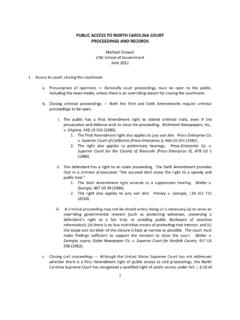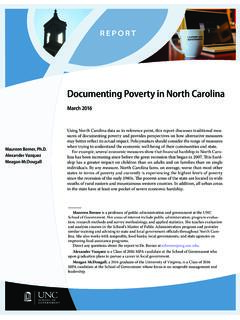Transcription of School of Government Legal Citation and Style Guide
1 School of Government Legal Citation and Style Guide Contents Introduction CONSTITUTIONS 16. NORTH CAROLINA CASES 2 Federal Constitution 16. Case Reporters 3 TEXT REFERENCES 16. OFFICIAL CASE REPORTERS 3 CITATIONS IN NOTES 17. UNOFFICIAL (REGIONAL) CASE REPORTER FOR State Constitutions 17. NORTH CAROLINA CASE LAW 3 TEXT REFERENCES 17. Case Citations to Official Reporters 3 CITATIONS IN NOTES 17. Parallel Citations 3 STATE ADMINISTRATIVE REGULATIONS, Blank Citations to Cases Not Published OPINIONS, ETC. 17. in Official Reporter 3 North Carolina Administrative Code 17. PUBLISHED IN REGIONAL REPORTER 3. Decisions from State Administrative Bodies 18. NOT PUBLISHED IN A REPORTER 4. NORTH CAROLINA OFFICE OF ADMINISTRATIVE. FEDERAL CASES 4 HEARINGS (OAH) 18. United States Supreme Court 4 NORTH CAROLINA INDUSTRIAL COMMISSION 18. Federal District and Circuit Courts 5 MISCELLANEOUS Citation FORMS 19. CIRCUIT COURT OF APPEALS 5 Pattern Jury Instructions 19.
2 DISTRICT COURT 5 Attorney General Opinions 19. GENERAL NOTES ABOUT CASE CITATIONS 6 North Carolina State Bar Ethics Opinions 19. What to Include/Exclude in Party North Carolina Rules of Professional Conduct 19. Names in Citations 6 CITATIONS TO SECONDARY SOURCES 20. Jurisdictional Indicators 7 Books 20. Short-Form Citations 7 School OF Government BOOKS 20. Pinpoint Citations 8 BOOKS FROM OTHER PUBLISHERS 20. PINCITES: FAQS 8 TREATISES/MULTI-VOLUME WORKS 20. MISCELLANEOUS QUESTIONS RELATED TO UNIQUE Citation FORMS 20. QUOTED MATERIAL AND PINCITES 10. Periodicals 20. Parentheticals, Subsequent and Prior History, and LAW REVIEW ARTICLES 20. Order of Such Elements in Case Citations 11. NEWSPAPER ARTICLES 20. PARENTHETICALS 11. Print 20. Weight of Authority Parentheticals 11. Online 20. Quoting/Citing Parentheticals 12 MAGAZINE ARTICLES 21. Explanatory Parentheticals 12. SUBSEQUENT AND PRIOR HISTORY THE BASICS 13 Print 21. ORDER OF PARENTHETICALS AND CASE Online 21.
3 HISTORIES IN CITATIONS 14 AMERICAN LAW REPORTS (ALR). ANNOTATIONS/ARTICLES 21. Treatment of a Case Name That Is AMERICAN BAR ASSOCIATION (ABA). Part of a Sentence 14 SECTION REPORTS 21. STATUTES 14 School of Government Bulletins 21. North Carolina Statutes, Session Laws 14 Websites 21. CITATIONS TO THE NORTH CAROLINA ONLINE-ONLY SOURCE 21. GENERAL STATUTES 14 ARTICLE LINKED FROM WEBSITE MAIN PAGE 21. NORTH CAROLINA SESSION LAWS 15 Blogs 21. Federal Statutes, Regulations 15 Podcasts 21. UNITED STATES CODE 15 ENTIRE SEASON 21. CODE OF FEDERAL REGULATIONS 16 SINGLE EPISODE 22. FEDERAL REGISTER 16. 2018 UNC School OF Government AUGUST 2018 | 1. GENERAL RULES APPLICABLE TO But see 25. ALL CITED SOURCES 22 Cf. 25. Use of Id. 22 OTHER Style POINTS 25. Use of Supra and Infra 22 Numbers/Numerals, Certain Ordinals 25. SHORT-FORM CITES 22 NUMBERS/NUMERALS 25. INTERNAL CROSS-REFERENCES 23 CERTAIN ORDINALS 26. Use of Signals 23 In Textual Sentences 26. NO SIGNAL NEEDED 23 In Citations 26.
4 SIGNAL REQUIRED 24. 24. See 24. See also 24. INTRODUCTION. With increasing frequency, School of Government Legal publications are being written according to the Style dictates of The Bluebook: A Uniform System of Citation . Some faculty authors (our Bluebook purists) are fully committed to this Style scheme, while others modify it to align more with personal preferences. Either approach is acceptable, provided it is followed consistently. Most authors choose to source their Legal material using a combination of superscripted foot- note indicators in text and below-the-rule footnotes containing source information, while a few use an inline Citation method (see, , North Carolina Crimes: A Guidebook on the Elements of Crime). Again, neither form is better; it's a matter of preference. The sections below discuss Citation forms for sources most commonly referenced in School Legal publications. Deviations from Bluebook Style are noted, as are trends in the way a particular source is being treated by our authors.
5 Additional information is offered when relevant. Sample citations are shaded in grey. NORTH CAROLINA CASES. The North Carolina Court System has two divisions, the Trial Division and the Appellate Divi- sion. The Trial Division comprises the District and Superior courts. The Court of Appeals and the Supreme Court make up the Appellate Division. Appellate Division cases are the ones most cited in works by School faculty. In a publication discussing only North Carolina law, after making a first full reference to the North Carolina Supreme Court, one can use the supreme court (lowercase) in subsequent ref- erences. In material that covers both state and federal law, to avoid confusion it's helpful to add state before references to North Carolina's top-level court ( the state supreme court ) if deci- sions of the United States Supreme Court are also being discussed. NOTE: Variations of state court names are acceptable. North Carolina Supreme Court/Supreme Court of North Carolina North Carolina Court of Appeals/Court of Appeals of North Carolina 2 | AUGUST 2018 2018 UNC School OF Government .
6 Case Reporters OFFICIAL CASE REPORTERS. There are two official reporters in North Carolina (each one's abbreviation, for Citation purposes, is in parentheses). North Carolina Reports ( ). North Carolina Court of Appeals Reports ( App.). UNOFFICIAL (REGIONAL) CASE REPORTER FOR NORTH CAROLINA CASE LAW. There is one unofficial reporter covering North Carolina's appellate courts (it is referred to as a regional reporter because it also includes cases from Georgia, South Carolina, Virginia, and West Virginia). South Eastern Reporter ( ). Case Citations to Official Reporters A basic case Citation contains the following elements: (1) the case name, (2) the reporter volume number, (3) the abbreviation for the reporter, (4) the page number in the reporter on which the case begins, and (5) the date of the decision. North Carolina Supreme Court: King v. Town of Chapel Hill, 367 400 (2014). North Carolina Court of Appeals: State v. Crow, 175 App. 119 (2005).
7 Parallel Citations When a case is published in both an official and an unofficial reporter, some authors choose to include both reporters in the Citation of the case. The reference to the regional reporter is called a parallel Citation . State v. Kochuk, 366 549, 742 801 (2013). State v. Coleman, 228 App. 76, 743 62 (2013). NOTE: School faculty used parallel citations as a matter of course for years, but this practice is on the decline. It is neither right nor wrong to include a parallel Citation ; it is simply a preference. However, if parallels are used in a given publication, every Citation should contain a parallel. Blank Citations to Cases Not Published in Official Reporter PUBLISHED IN REGIONAL REPORTER. When a decision is not, or has yet to be, published in an official reporter but is available in a regional reporter, many faculty authors will cite the decision using a blank cite, that is, three underscores, followed by the abbreviated official reporter name, followed by another three underscores.
8 ___ ___. The blank cite is then followed, after a comma, by a regional reporter Citation and the date of decision (in parentheses). State v. Bullock, ___ App. ___, 785 746 (2016). 2018 UNC School OF Government AUGUST 2018 | 3. ALTERNATIVE: Some authors choose to dispense with blank cites and use only the regional reporter cite. This is acceptable, provided the jurisdictional indicator is placed before the deci- sional year in the parentheses at the end of the Citation . The state court of appeals is abbreviated Ct. App. and the state supreme court is abbreviated for purposes of jurisdictional labeling. Note that the jurisdictional abbreviation for the North Carolina Court of Appeals ( Ct. App.) is not the same as the abbreviation for the official reporter ( App.) for this appel- late body used in citations. (Jurisdictional abbreviations are found in Bluebook Table 1. For non . North Carolina cases especially, it's a good idea to verify that an author has used the correct abbreviation.)
9 State v. Bullock, 785 746 ( Ct. App. 2016). NOT PUBLISHED IN A REPORTER. When a decision is not, or has yet to be, published in either an official or a regional reporter, some faculty authors choose to use a double blank Citation . State v. Huey, ___ ___, ___ ___ (Sept. 29, 2017). Such cites often function as placeholders, with the author (or editor) updating them as the pro- duction process rolls on and publication of the decision finally occurs. ALTERNATIVE: If a decision is not published in any reporter but is available on an electronic database ( , Westlaw, LEXIS, Bloomberg Law), it is acceptable (and more helpful for readers, I. think), in lieu of a double blank cite, to use a database Citation . This Citation should contain the following elements: (1) case name, (2) docket number, (3) unique number assigned to the case by the database proprietor, (4) jurisdiction and date (including month and day) in parentheses. State v. Huey, No. 355PA15, 2017 WL 4322611 ( Sept.)
10 29, 2017). United States ex rel. Customs Fraud Investigations, LLC v. Victaulic Co., No. 13-2983, 2015 BL 103347 ( Pa. Apr. 10, 2015). FEDERAL CASES. United States Supreme Court United States Reports abbreviated is the official reporter of Supreme Court opin- ions. (Aside: After making a first full reference to United States Supreme Court, it is common practice to use Supreme Court or the Court (capitalized) in subsequent mentions.). There are several unofficial reporters of Supreme Court cases (each one's abbreviation, for Citation purposes, is in parentheses following the full reporter name): Supreme Court Reporter (S. Ct.); United States Supreme Court Reports, Lawyers' Edition (L. Ed.); and United States Law Week ( ). If an opinion has been published in United States Reports, the Citation to it does not require a parallel. Mich. Dep't of State Police v. Sitz, 496 444 (1990). However, if a case has not been published in United States Reports at the time it is cited by an author, the practice at the School has been to use a blank United States Reports cite, followed by a Citation to the case in the Supreme Court Reporter.









